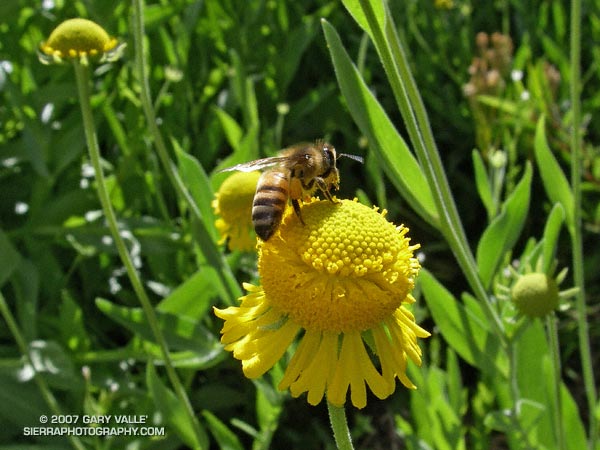
A bee forages on Bigelow’s sneezeweed (Helenium bigelovii) at Little Jimmy Spring. From Sunday’s Islip – Baden-Powell loop.

A bee forages on Bigelow’s sneezeweed (Helenium bigelovii) at Little Jimmy Spring. From Sunday’s Islip – Baden-Powell loop.
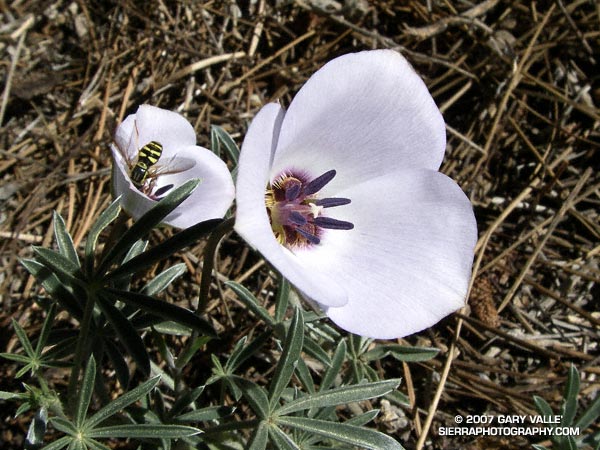
Mariposa lilies (Calochortus invenustus) blooming through the palmate leaves of a lupine at about 8500 ft., near Sawmill Mountain, west of Mt. Pinos.
According to data from the Consortium of California Herbaria, this species was documented in the Mt. Pinos area as early as 1897.
The wasp-like insect is a hover fly, probably Chrysotoxum festivum.
From Sunday’s Mt. Pinos-Mt. Abel Out & Back run.
Related posts: Plummer’s Mariposa Lily, Bee Fly On Western Wallflower
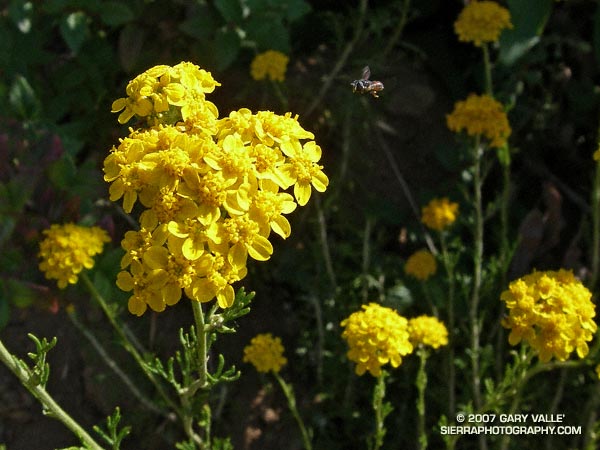
Perfectly sized to work the minute central disk flowers of golden yarrow, a tiny insect — perhaps a syrphid fly — hovers a few millimeters from the plant, assessing the risk of continuing to feed.
The compound flower head of the golden yarrow (Eriophyllum confertiflorum) is about the size of a green pea (10mm), and the individual disk flowers at its center are about 1/5 as large (2mm).
From a run at Sage Ranch Park on May 28, 2007.
Related post: Bee Fly on Western Wallflower.
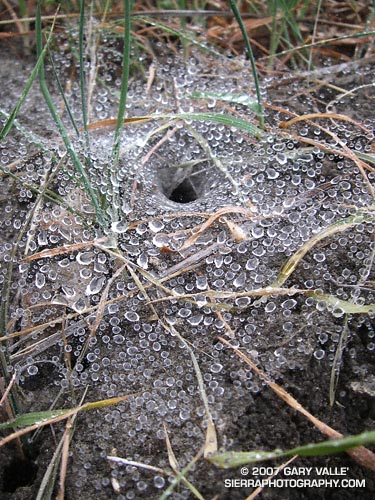
We received a little rain in the Los Angeles area earlier this week. There was just enough light rain to dampen my shirt, muddy my running shoes, and ornament this web with droplets of water. Refreshing as it was, the precipitation did little to relieve our ongoing drought.
To date, according to NWS data, this is the driest water year in Los Angeles since recordkeeping began in 1877. From July 1, 2006 to March 22, 2007 Downtown Los Angeles (USC) has recorded only 2.47 inches of rain. This is 10.79 inches below normal. Checking back through NWS records, 2.47 inches is the total amount of rain recorded in Downtown Los Angeles from May 23, 2006 through today — a period of 10 months!
In the past few years Los Angeles has experienced a number of weather extremes. The driest water year on record for Los Angeles was just set in 2001-2002, when 4.42 inches were recorded. Then in 2004-2005, Los Angeles was deluged with 37.25 inches of rain — the second wettest on record. During that period, Opids Camp in the San Gabriel Mountains recorded over 100 inches of precipitation! In July of last year Pierce College in Woodland Hills recorded a new all time high temperature for that station of 119°F. This may have been the highest temperature ever recorded in Los Angeles County. In mid January of this year many new record low temperatures for the date were set in the Southern California area. Pierce College plunged to a record low of 20°F (-6.7°C) and a temperature of 10.4°F (-12°C) was recorded at a research site in the Santa Monica Mountains.
Computer models are indicating another chance of rain early next week. At the moment, the system looks like it could produce rainfall amounts similar to Tuesday’s system, perhaps a little more. But with the equatorial Pacific and atmosphere looking more and more La Nina like, significant rain is looking less likely, and we may be talking about record drought in Southern California for many months to come. We’ll see!
The photo of the wet spider web was taken near Lasky Mesa in Upper Las Virgenes Canyon Open Space Preserve (formerly Ahmanson Ranch) on Tuesday, March 20, 2007. The funnel shaped web is probably that of the western grass spider, Agelenopsis aperta.
Related posts: Chaparral Freeze, The Color of Rain, El Nino Drought, Sunset Snow Shower, Rainy Morning on Rocky Peak Road.
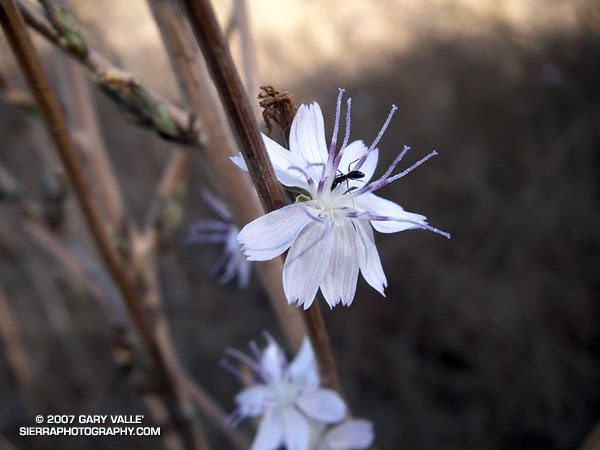
An ant forages among the florets of a wreath plant.
I’ve run past wreath plants thousands of times in the chaparral of local open space areas. At a glance, the nondescript wiry brown plant isn’t very appealing. But it’s one of a few plants you’ll see blooming in the chaparral in the Fall, so on a run this last November I took a closer look. This revealed a lavender-tinged composite flower that is anything but mundane. And, as I was to discover, a case of probable mistaken identity, and an example of one of the ways new species occur.
Three field guides in my library identify the plant pictured above as Twiggy Wreath Plant (Stephanomeria virgata). But, as discussed by Tom Chester, there is some confusion regarding it’s characteristics and identity. It could be the case that many Southern California plants previously identified as S. virgata may actually be San Diego Wreath Plant (S. diegensis), including those in the Santa Monica Mountains.
The plants are very similar, but according to the identification key for the genus Stephanomeria in the Jepson Manual can be distinguished by a groove along the length of a seed (achene). This isn’t something easily done in the field. The achenes are so tiny that they are best seen in a strong loupe or a low power microscope. Wayne’s World Volume 9 (Number 3) Fall 2000 has some photographs of the achenes and groove.
So why are S. virgata and S. diegensis so similar? The genetic relationship of various members of the genus Stephanomeria has been researched and it appears likely that S. diegensis is a relatively recent species that resulted from a natural cross of S. exigua and S. virgata.
The photograph of the foraging ant was taken on a run at Sage Ranch on November 5, 2006. Based on examination of some achenes from wreath plants in the area, the plant is probably Stephanomeria diegensis.
Technical papers:
Genetic Evidence for the Hybrid Origin of the Diploid Plant Stephanomeria diegensis
G. P. Gallez, L. D. Gottlieb
Evolution, Vol. 36, No. 6 (Nov., 1982), pp. 1158-1167
Phylogeny of Stephanomeria and related genera (compositae–lactuceae) based on analysis of 18S–26S nuclear rDNA ITS and ETS sequences
Joongku Lee, Bruce G. Baldwin and L. D. Gottlieb
American Journal of Botany. 2002;89:160-168
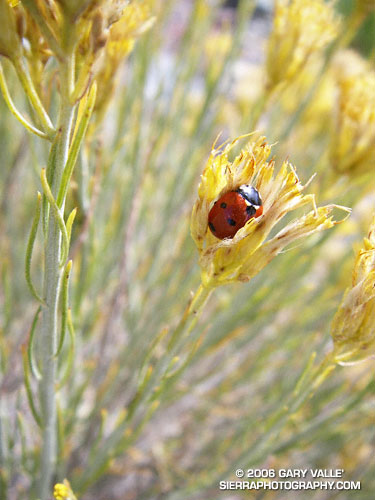
On a chilly October morning, following a cold night at 9400 ft., a Seven-spotted Lady Beetle is slow to move from her bivouac amid the blossoms of a Rabbitbrush.
The photo is from the North Backbone Trail Revisited hike and run.